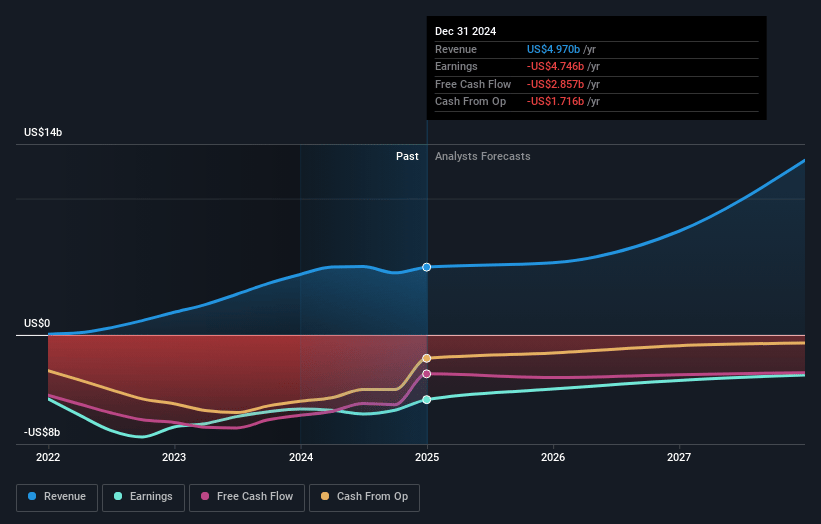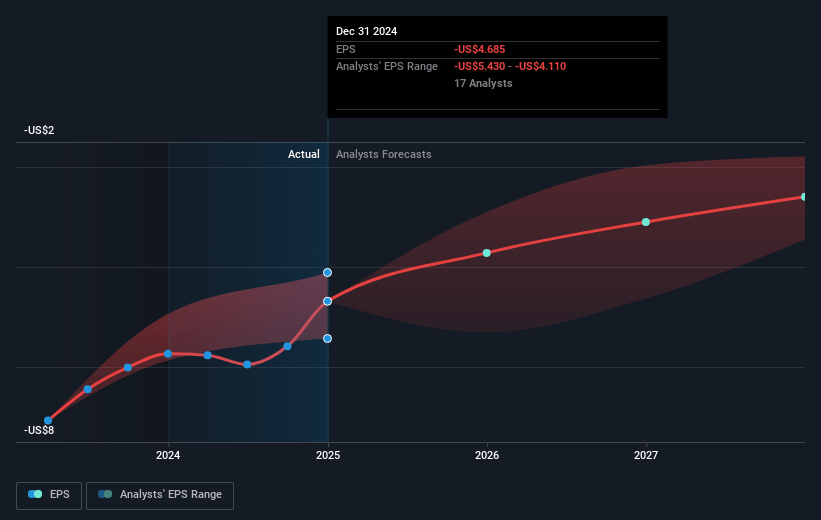Key Takeaways
- Strategic product mix and cost reductions are set to enhance margins, while platform innovations promise increased profitability and earnings.
- Partnerships and advanced tech development are expected to expand revenue opportunities and secure necessary capital for scaling operations.
- Regulatory challenges, execution risk in scaling, and reliance on regulatory credits and software revenue could negatively impact Rivian's margins and earnings.
Catalysts
About Rivian Automotive- Designs, develops, manufactures, and sells electric vehicles and accessories.
- Rivian's significant reduction in the cost of goods sold (COGS) per vehicle and increased average selling prices due to product mix improvements are expected to enhance future net margins.
- The introduction of the R2 platform in 2026, designed with half the bill of materials compared to R1, signifies a substantial cost structure improvement likely to boost future earnings and profitability.
- The partnership with Volkswagen Group aligns with joint ventures that are expected to generate significant incremental revenue over the next four years, enhancing Rivian's revenue streams.
- Rivian's advancements in autonomy, featuring new technology and end-to-end AI capabilities, are anticipated to open new revenue opportunities through potential paid features in self-driving capabilities.
- The U.S. Department of Energy loan, along with funds from the Volkswagen joint venture, is expected to secure Rivian's capital needs, supporting future operations and scaling through the R2 and R3 launches, which should positively impact free cash flow and long-term earnings.
Rivian Automotive Future Earnings and Revenue Growth
Assumptions
How have these above catalysts been quantified?- Analysts are assuming Rivian Automotive's revenue will grow by 34.3% annually over the next 3 years.
- Analysts are not forecasting that Rivian Automotive will become profitable in next 3 years. To represent the Analyst Price Target as a Future PE Valuation we will estimate Rivian Automotive's profit margin will increase from -95.5% to the average US Auto industry of 5.9% in 3 years.
- If Rivian Automotive's profit margin were to converge on the industry average, you could expect earnings to reach $707.8 million (and earnings per share of $0.51) by about April 2028, up from $-4.7 billion today.
- In order for the above numbers to justify the analysts price target, the company would need to trade at a PE ratio of 39.7x on those 2028 earnings, up from -3.2x today. This future PE is greater than the current PE for the US Auto industry at 20.2x.
- Analysts expect the number of shares outstanding to grow by 7.0% per year for the next 3 years.
- To value all of this in today's terms, we will use a discount rate of 11.41%, as per the Simply Wall St company report.
Rivian Automotive Future Earnings Per Share Growth
Risks
What could happen that would invalidate this narrative?- Rivian faces potential policy and regulatory challenges, which could impact the demand for their vehicles and affect EBITDA. A fluid regulatory environment poses risks to revenues and net margins.
- There is notable execution risk related to the scaling and production of new products like the R2 and R3, and the risk of cannibalization between R1 and R2 could impact earnings if not managed effectively.
- The company plans a substantial plant shutdown to integrate new production lines, which could disrupt operations and impact revenue and inventory levels in the short term.
- The financial success of Rivian is heavily reliant on reductions in cost per unit and raw material expenses. Failure to maintain or increase these efficiencies could negatively impact net margins.
- Rivian's financial outlook depends significantly on revenue and profit from regulatory credits and software and services, which may fluctuate based on external market factors, affecting overall earnings.
Valuation
How have all the factors above been brought together to estimate a fair value?- The analysts have a consensus price target of $14.671 for Rivian Automotive based on their expectations of its future earnings growth, profit margins and other risk factors. However, there is a degree of disagreement amongst analysts, with the most bullish reporting a price target of $23.0, and the most bearish reporting a price target of just $6.1.
- In order for you to agree with the analyst's consensus, you'd need to believe that by 2028, revenues will be $12.0 billion, earnings will come to $707.8 million, and it would be trading on a PE ratio of 39.7x, assuming you use a discount rate of 11.4%.
- Given the current share price of $13.28, the analyst price target of $14.67 is 9.5% higher.
- We always encourage you to reach your own conclusions though. So sense check these analyst numbers against your own assumptions and expectations based on your understanding of the business and what you believe is probable.
How well do narratives help inform your perspective?
Disclaimer
Warren A.I. is a tool utilizing a Large Language Model (LLM) that ingests data on consensus price targets, forecasted revenue and earnings figures, as well as the transcripts of earnings calls to produce qualitative analysis. The narratives produced by Warren A.I. are general in nature and are based solely on analyst data and publicly-available material published by the respective companies. These scenarios are not indicative of the company's future performance and are exploratory in nature. Simply Wall St has no position in the company(s) mentioned. Simply Wall St may provide the securities issuer or related entities with website advertising services for a fee, on an arm's length basis. These relationships have no impact on the way we conduct our business, the content we host, or how our content is served to users. The price targets and estimates used are consensus data, and do not constitute a recommendation to buy or sell any stock, and they do not take account of your objectives, or your financial situation. Note that Warren A.I.'s analysis may not factor in the latest price-sensitive company announcements or qualitative material.
Read more narratives

RIVN The Bull Will Continue To Grow





